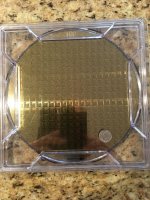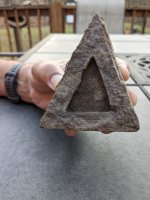pulltabfelix
Bronze Member
- Jan 29, 2018
- 1,011
- 1,630
- Detector(s) used
- Currently have CTX3030 and Vanquish 440.
- Primary Interest:
- Relic Hunting
My wife worked for Intel for many years. I remember back in the late 1970’s she brought home a chart that predicted the micro processing power for their chip line for the next 30 years. It was a steady upward curve from the old early pc chip the 8088. Guess what, it was almost dead on the money. Gordon Moore of Intel fame developed Moore’s Law states that processor speeds, or overall processing power for computers will double every two years and the price will continue to decrease. Some say Moore’s law has hit a wall. I don’t think so. To get around that wall they invented multi-processors working in parallel. Want to know how small these processors are? See the image include with this article with an actual silicon wafer with hundreds of computer processor chips before they were cut into small chips and mounted in the casing. Keep in mind this wafer came from the late 1980’s. The micro processors of today are much smaller.
Here is how Garrett or any other metal detecting manufacture will get the jump on Minelab if they don’t do it first.
Technology everywhere is getting smaller, smarter and invading more products that were before just products that switch on and use.
The big new thing in software that makes these new powerful microprocessors useful is AI or artificial intelligence and machine learning where products that can actually learn.
In the present metal detecting world a small example of this I guess is the Equinox tracking ground balance. The microprocessor when told will keep auto adjusting your ground balance.
With the advances of AI, and machine learning here is what I think we may come to expect in our new metal detectors in the next five years.
You go to a hunt site and put your detector in the learn mode and swing over some of the ground and the detector will analyze the soil and perform automatic ground balance and also detect any noise interference and do an auto noise cancel.
While swinging it will analyze all of the signals beneath the coil and learn what is typically beneath the coil on this hunt. It will either already know what you are not looking for and not report at all the pull tabs, can slaw etc. It will also know when there is a good target. It will only report good targets.
How will it know this? There will be a reject button and on the last signal after you dig something that is junk, you press the reject learn button and the detector will know that this last signal is of no use to you and learn that information for future compares. It will store the complete data of the rejected signal. Millions of bits of information that go way beyond mere audio sounds and display readings. It will develop a complete profile on the unwanted target. It will do this for all the targets you dig and decide to manual learn reject until it no longer reports any of your junk targets.
On the flip side when you dig a good target like a silver dime or gold ring it again will store the huge amounts of data on the target when you pressed the accept learn button. Soon your detector on this hunt will know exactly what you are looking for and not looking for. Yes you can on the Equinox 800 reject and add to the discriminate functions so this type of learning is available, but on a very limited means. The new machine will be able to store millions of bits of information on all types of targets that your present day detectors are incapable of doing so.
You will be able to store these different hunt profiles to use later when you are hunting similar types of sites.
Remember these future microprocessors will be capable of storing much more detail data about good and bad targets than is now reported with our current detectors with tones and numbers. Tones are difficult for the average detectorists to really process the fine differences. Some detectorists with great hearing abilities and memories and determination can do this exceptionally well and are the more successful hunters.
But to the average detectorist deciding if the signal is a screw cap or silver coin can be a challenge. Not with the new breed of metal detectors using AI and machine learning capabilities. Ironically these new breed of AI detectors will evolve back into beep and dig detectors like the detectors of old but with almost absolute confidence on reporting only good targets.
These new detectors will have hundreds of gigabytes of storage to handle these new saved learned hunt profiles and the processor speeds will be 100X or 1000x the speed of current microprocessors of today able to pick out the even smallest differences and characteristics of these targets. They will absolutely know the difference between silver, copper, aluminum, iron, brass etc. Machine learning and AI is really about processor speed and storage. The rest is up to the machine language programmer who will write programs that allow our future metal detectors to learn from our actual usage of our metal detectors and only report the targets we are seeking. PS: I am maxxkatt on other metal detecting forums.

Here is how Garrett or any other metal detecting manufacture will get the jump on Minelab if they don’t do it first.
Technology everywhere is getting smaller, smarter and invading more products that were before just products that switch on and use.
The big new thing in software that makes these new powerful microprocessors useful is AI or artificial intelligence and machine learning where products that can actually learn.
In the present metal detecting world a small example of this I guess is the Equinox tracking ground balance. The microprocessor when told will keep auto adjusting your ground balance.
With the advances of AI, and machine learning here is what I think we may come to expect in our new metal detectors in the next five years.
You go to a hunt site and put your detector in the learn mode and swing over some of the ground and the detector will analyze the soil and perform automatic ground balance and also detect any noise interference and do an auto noise cancel.
While swinging it will analyze all of the signals beneath the coil and learn what is typically beneath the coil on this hunt. It will either already know what you are not looking for and not report at all the pull tabs, can slaw etc. It will also know when there is a good target. It will only report good targets.
How will it know this? There will be a reject button and on the last signal after you dig something that is junk, you press the reject learn button and the detector will know that this last signal is of no use to you and learn that information for future compares. It will store the complete data of the rejected signal. Millions of bits of information that go way beyond mere audio sounds and display readings. It will develop a complete profile on the unwanted target. It will do this for all the targets you dig and decide to manual learn reject until it no longer reports any of your junk targets.
On the flip side when you dig a good target like a silver dime or gold ring it again will store the huge amounts of data on the target when you pressed the accept learn button. Soon your detector on this hunt will know exactly what you are looking for and not looking for. Yes you can on the Equinox 800 reject and add to the discriminate functions so this type of learning is available, but on a very limited means. The new machine will be able to store millions of bits of information on all types of targets that your present day detectors are incapable of doing so.
You will be able to store these different hunt profiles to use later when you are hunting similar types of sites.
Remember these future microprocessors will be capable of storing much more detail data about good and bad targets than is now reported with our current detectors with tones and numbers. Tones are difficult for the average detectorists to really process the fine differences. Some detectorists with great hearing abilities and memories and determination can do this exceptionally well and are the more successful hunters.
But to the average detectorist deciding if the signal is a screw cap or silver coin can be a challenge. Not with the new breed of metal detectors using AI and machine learning capabilities. Ironically these new breed of AI detectors will evolve back into beep and dig detectors like the detectors of old but with almost absolute confidence on reporting only good targets.
These new detectors will have hundreds of gigabytes of storage to handle these new saved learned hunt profiles and the processor speeds will be 100X or 1000x the speed of current microprocessors of today able to pick out the even smallest differences and characteristics of these targets. They will absolutely know the difference between silver, copper, aluminum, iron, brass etc. Machine learning and AI is really about processor speed and storage. The rest is up to the machine language programmer who will write programs that allow our future metal detectors to learn from our actual usage of our metal detectors and only report the targets we are seeking. PS: I am maxxkatt on other metal detecting forums.







